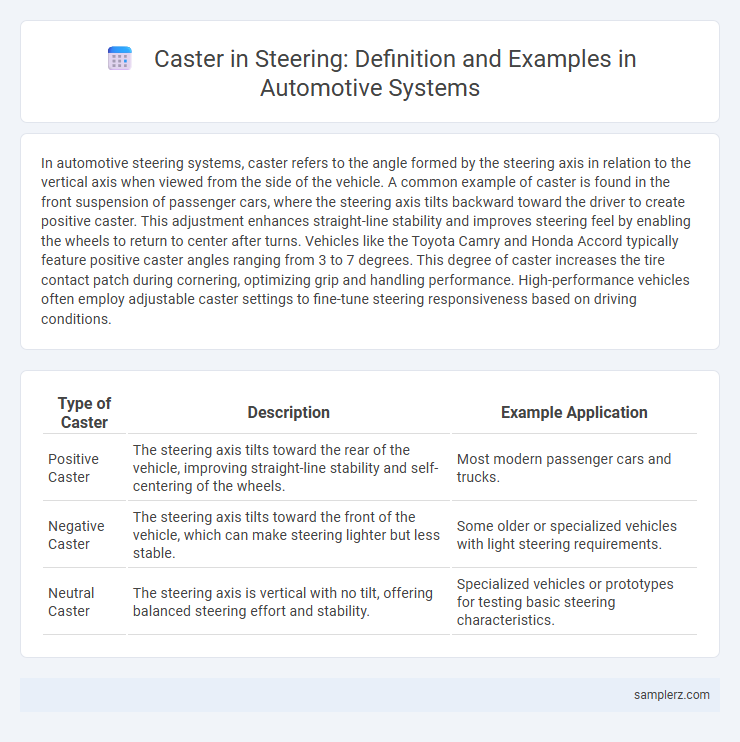In automotive steering systems, caster refers to the angle formed by the steering axis in relation to the vertical axis when viewed from the side of the vehicle. A common example of caster is found in the front suspension of passenger cars, where the steering axis tilts backward toward the driver to create positive caster. This adjustment enhances straight-line stability and improves steering feel by enabling the wheels to return to center after turns. Vehicles like the Toyota Camry and Honda Accord typically feature positive caster angles ranging from 3 to 7 degrees. This degree of caster increases the tire contact patch during cornering, optimizing grip and handling performance. High-performance vehicles often employ adjustable caster settings to fine-tune steering responsiveness based on driving conditions.
Table of Comparison
| Type of Caster | Description | Example Application |
|---|---|---|
| Positive Caster | The steering axis tilts toward the rear of the vehicle, improving straight-line stability and self-centering of the wheels. | Most modern passenger cars and trucks. |
| Negative Caster | The steering axis tilts toward the front of the vehicle, which can make steering lighter but less stable. | Some older or specialized vehicles with light steering requirements. |
| Neutral Caster | The steering axis is vertical with no tilt, offering balanced steering effort and stability. | Specialized vehicles or prototypes for testing basic steering characteristics. |
Understanding Caster Angle in Automotive Steering
The caster angle in automotive steering refers to the tilt of the steering axis from the vertical axis when viewed from the side of the vehicle, typically measured in degrees. This angle significantly influences vehicle stability, steering effort, and self-centering behavior by providing directional control and enhancing straight-line tracking. Proper caster adjustment improves road handling, reduces steering wander, and ensures safer maneuverability, especially at high speeds.
Positive vs. Negative Caster: Key Differences
Positive caster in automotive steering angles the steering axis rearward, enhancing straight-line stability and improving handling during high-speed driving. Negative caster tilts the steering axis forward, which can reduce steering effort but often leads to less directional stability and increased tire wear. The key difference lies in how positive caster promotes self-centering of the wheels, while negative caster typically decreases this effect, impacting overall vehicle control.
Real-World Example: Caster Angle in Sports Cars
In sports cars such as the Porsche 911, the caster angle is typically set between 5 and 7 degrees to enhance high-speed stability and steering feel. This positive caster angle increases the self-aligning torque, allowing drivers to maintain precise control during aggressive cornering and rapid lane changes. Optimizing caster in performance vehicles improves overall handling dynamics and contributes to improved driver confidence on both road and track.
Caster Settings in Off-Road Vehicles
Caster settings in off-road vehicles significantly influence steering stability and handling on rough terrain. Positive caster angles, typically ranging from 4 to 8 degrees, enhance directional control by increasing straight-line stability and steering feel. Adjusting caster settings optimizes wheel alignment, reduces steering effort, and improves maneuverability in challenging off-road conditions.
Impact of Caster on Steering Stability
Caster angle in automotive steering directly influences directional stability by affecting the self-centering torque on the wheels. A positive caster angle improves straight-line tracking and reduces driver effort by enhancing the steering wheel's tendency to return to center after a turn. Excessive caster, however, can increase steering effort and cause tire wear, highlighting the importance of optimizing caster settings for balanced steering stability and vehicle control.
Caster Angle in Modern SUVs Explained
The caster angle in modern SUVs typically ranges between 3 to 7 degrees, enhancing straight-line stability and steering feel during high-speed driving. A positive caster angle tilts the steering axis toward the driver, improving self-centering of the wheels and reducing driver effort on rough terrains. Manufacturers optimize caster angles based on suspension geometry and vehicle weight distribution to balance maneuverability with highway stability.
How Caster Influences Steering Wheel Returnability
Caster is the angle of the steering axis in relation to the vertical axis of the wheel, typically measured in degrees. A positive caster angle improves steering wheel returnability by creating a self-aligning torque that naturally centers the wheels after a turn. This effect enhances vehicle stability, reduces driver effort, and improves overall handling during cornering and straight-line driving.
Caster Adjustments in Performance Tuning
Caster adjustments in steering systems significantly influence vehicle stability and cornering performance by altering the caster angle, which affects the self-centering action of the steering wheel. Increasing positive caster improves straight-line stability and steering feedback, essential for high-speed performance tuning, while reducing caster enhances maneuverability at lower speeds. Precise caster tuning balances responsiveness with driver comfort, optimized through suspension geometry modifications tailored to specific automotive performance goals.
Case Study: Caster Angle in Classic Muscle Cars
The caster angle in classic muscle cars, such as the 1969 Chevrolet Camaro, significantly enhances straight-line stability and steering feel by tilting the steering axis backward, promoting self-centering of the wheels. Studies reveal that an optimal caster angle between 5 to 8 degrees balances improved cornering performance with reduced steering effort in these vintage vehicles. Adjusting the caster angle directly influences tire wear patterns and suspension geometry, critical factors in maintaining the authentic driving experience of classic muscle cars.
Diagnosing Caster Issues in Everyday Vehicles
Diagnosing caster issues in everyday vehicles involves checking the angle of the steering pivot as it tilts toward or away from the driver, which affects directional stability. Symptoms such as pulling to one side, uneven tire wear, or a wandering steering wheel often indicate a misaligned caster angle. Using an alignment machine or performing a road test can help identify and correct improper caster settings to improve handling and vehicle safety.

example of caster in steering Infographic
 samplerz.com
samplerz.com